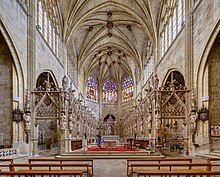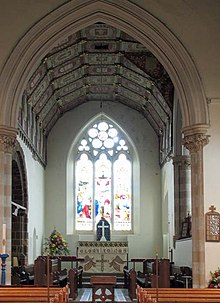Chancel




In
.Overview
The chancel is generally the area used by the clergy and choir during worship, while the congregation is in the nave. Direct access may be provided by a priest's door, usually on the south side of the church.[2] This is one definition, sometimes called the "strict" one; in practice in churches where the eastern end contains other elements such as an ambulatory and side chapels, these are also often counted as part of the chancel, especially when discussing architecture.[3] In smaller churches, where the altar is backed by the outside east wall and there is no distinct choir, the chancel and sanctuary may be the same area. In churches with a retroquire area behind the altar, this may only be included in the broader definition of chancel.
In a cathedral or other large church, there may be a distinct choir area at the start of the chancel (looking from the nave), before reaching the sanctuary, and an
In churches with a traditional Latin cross plan, and a transept and central crossing, the chancel usually begins at the eastern side of the central crossing, often under an extra-large chancel arch supporting the crossing and the roof. This is an arch which separates the chancel from the nave and transept of a church.[4] If the chancel, strictly defined as choir and sanctuary, does not fill the full width of a medieval church, there will usually be some form of low wall or screen at its sides, demarcating it from the ambulatory or parallel side chapels.
As well as the altar, the sanctuary may house a credence table and seats for officiating and assisting ministers. In some churches, the congregation may gather on three sides or in a semicircle around the chancel. In some churches, the pulpit and lectern may be in the chancel, but in others these, especially the pulpit, are in the nave. The presbytery is often adorned with chancel flowers.[5]
Name
The word "chancel" derives from the French usage of chancel from the Late Latin word cancellus ("lattice").[1][6] This refers to the typical form of rood screens. The chancel was formerly known as the presbytery, because it was reserved for the clergy.[7]
History
In

A large (or "deep") chancel made most sense in monasteries and cathedrals where there was a large number of singing clergy and boys from a
Following the exposition of the doctrine of
After the Reformation Protestant churches generally moved the altar (now often called the
References
Citations
- ^ ISBN 0198606788.
- ^ "priest's door", A Dictionary of Architecture and Landscape Architecture, Oxford: Oxford University Press, 2000.
- ^ Fleming, "Chancel"; Pevsner, p. 349
- ISBN 0486132110.
- ^ Wilson, Adelaide B.; Wilson, Lois (1967). Flowers for Your Church. M. Barrows. p. 26.
- ^ Harper, Douglas (2001). "Chancel". Online Etymology Dictionary. Retrieved 2013-10-29.
- ^ Herbermann, Charles, ed. (1913). . Catholic Encyclopedia. New York: Robert Appleton Company.
- ^ Online text
- ^ White, 93-97
Bibliography
- Fleming, John; Honour, Hugh; Pevsner, Nikolaus (1986), Dictionary of Architecture, 1980 (3 ed.), Penguin Books Ltd.
- Pevsner, Nikolaus; Priscilla Metcalf, The Cathedrals of England; Southern England, 1985, Viking
- White, James F., The Cambridge Movement: The Ecclesiologists and the Gothic Revival, 1962 (2004 reprint), Wipf and Stock Publishers, ISBN 1592449379, 9781592449378, google books
- . Encyclopædia Britannica. Vol. 5 (11th ed.). 1911. p. 832.
